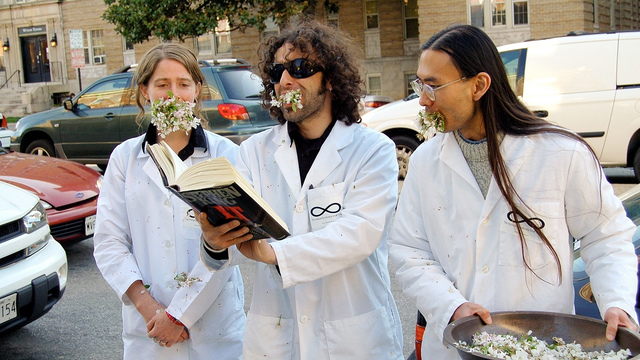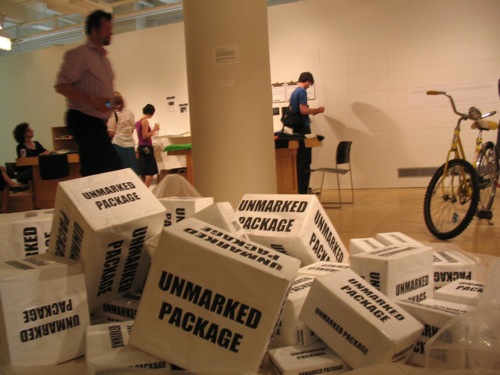Transforming public spaces with the Institute for Infinitely Small Things
Open Culture
Renaming Cambridge, sushiesque CC BY-NC 2.0
The Institute for Infinitely Small Things addresses the commons through an art for all approach to engage with the political through their work in public spaces. As a research and art praxis group, their work is interdisciplinary and site-specific, yet it draws on data, multimedia, and documentation to concretize their ephemeral performance pieces on the web and beyond.
Over the past thirteen years, the collective has “conducted creative, participatory research to temporarily transform public spaces dominated by non-public agendas,” engaging with “social and political tiny things.” In encouraging interaction with the spaces that surround their installations, the Institute’s work is personal and political and works as a vehicle for local change wherever they find themselves.
Many of the Institute’s projects can be perused on the website of Berlin-based artist Nicole Siggins, who answered questions for this interview, or at their website.
As an artist-run organization concerned with public engagement, what kinds of tactics do you use to encourage participation in your projects?
We perform many of our actions in public view, whether that be on the street in the middle of a busy square, while engaging a classroom, or in an exhibition space. When working in public space we use humor and spectacle to spark curiously in the people around us. This in turn brings people in closer to us, where we can then engage them in the project by asking questions about what they see and perceive, both in the actions we are taking and how it relates to the world and spaces around them. Tactics we have used in the past are wearing lab coats, moving our bodies in unexpected ways, using the landscape in a way that is different from its intended use, creating barriers, getting in the way, and obstructing pathways as a way of encouraging interaction.
A good deal of your work is temporal, yet it is the kind of art that thrives on the internet – videos, remixes, and datasets, like the Corporate Commands dataset. How do you balance site-specific installations with sharing your work online? Do you believe that making your work accessible to a larger audience will encourage its dissemination?
It is important to us that the work continue on its own path once we are finished with it. We are less interested in claiming ownership over the works than we are these works existing on their own to inspire others to engage more consciously and constructively with the world around them. Site specific installations are important because we get to engage with the local public in a space that belongs to them. This is, at heart, the core of the work. However, we truly hope that seeing our work online encourages others to continue to engage with the subject matter long after any site specific installation is over. We do hope that making our work accessible to a larger audience will encourage its dissemination and will encourage people to come up with their own similar ideas or begin their own Institute like groups.

The Institute for Infinitely Small Things – Corporate Commands: Say It With Flowers via Eyebeam CC BY-NC 2.0
So many of your installations involve seeking meaning in objects, work, capital, feelings, and politics. How do you bring the personal into the political in your work? How do you conceive of these interventions and installations?
We believe that the personal is the political. Our ideas come from what is going on around us in our political and personal climate. For example, our project “Unmarked Package: A Case for Feeling Insecure” brought us through may different Chicago neighborhoods, setting up a temporary installation of empty boxes which were wrapped in white paper and marked “unmarked package” on all four sides. We then spoke with the residents of each neighborhood about how they would react if they saw an unmarked package and if being super vigilant made them feel safer. This idea emerged from living in a world where we are repeatedly told over intercoms and loudspeakers in train stations and airports to be cautions and to be on the look out for “suspicious behaviour” or “unmarked packages.” Our project was a vehicle to better understand the permeating culture of fear that exists all around us and to engage the public on whether these announcements and behaviors overall made us feel more safe or threatened. Thus, the objects that appear in our works are only a vessel to get the conversation going and to begin a dialogue about what is happening around us in our world.
Video: CC BY-N.C. 3.0
As a research institute, you came of age during the Bush administration and continued to create work through Occupy and other social movements. How do you see your work changing in scope with the new administration in the US? What’s next for the institute?
There is definitely a lot to talk about with the new administration in the USA. Last spring we ran the Campaign Limericks project, a series of events that analysed the speeches of all the political candidates using DataBasic. The goal of the project was to remix the presidential candidates’ speeches into limericks by finding the most used words in the speeches. It went over well and some of the limericks came out really great! We had events in Boston, Des Moines, and Hartford. Our projects tend to emerge out of community discussion. Right now there is so much going on with the new administration that it is difficult to focus on one topic. However, the ideas of borders, space, and fear have been past topics of our work that only seem more relevant in the current political climate. We hope that we are able to find ways to speak to a greater audience and bring more light to the issues at hand. We want to get people involved and to feel like they are an important piece in changing the world and raising awareness.

“Unmarked Packages” by ryan griffis CC BY-SA 2.0
What do the commons mean to you? How does your work foster a robust global commons? What do you see as the future of the commons?
In Boston, when we refer to commons, we are often speaking about a physical space, such as the Boston Common. In this sense, our work relates to and promotes interest in the public spaces around us and how they are used. We hope to influence others to take stock of the spaces around them and have a critical view about why things happen as they do. Why are all the streets in Cambridge, Massachusetts named after white men when the current city is so diverse? Why are people harassed and accused of having crossed the border when a border itself is placed right though their previously existing community? Why is it impossible to find something free to to in Harvard Square? The commons and public space should belong to everyone. Our work aims to help people think about and realize that in their own lives.
As for the more abstract commons (information, ideas and concepts that are free for anyone to use) the Institute works to involve everyone in the art we perform. We strive to show that art and research is the commons – it’s accessible to everyone! Making art and using performative research to get people thinking and talking helps bring people together to have important conversations about what is going on in our communities. Sharing our art and ideas on the Internet further spreads the invitation to the wider world. In this way, we use the commons in both senses to invite people to begin to have these important conversations.
Posted 15 February 2017